



Humans have breached space outside our world, and we want to go further. But as with any marvel of science, there are barriers to overcome.
Working closely with our customers has given us valuable insights into Additive Manufacturing’s role in the context of an aerospace application.
Sending a large spacecraft, the size of a small bus, into the upper atmosphere takes an incredible amount of force. Not to mention, the immense thought and calculations to figure out properties like mechanical loads, thermal capabilities, service life and so much more. With max payloads defined, it is vital to be constantly searching for efficiencies and reductions where possible. Reducing mass in one assembly allows more resources to be allocated to other assemblies and functional equipment onboard.
This is where Additive Manufacturing (AM) comes in. Through unique efficiencies and capabilities in areas of design, AM brings new possibilities and ways of thinking to gain efficiencies via mass reduction. However, it must be done as a calculated response driven by key considerations. For example, after criteria such as thermal and mechanical loading requirements are defined, structural engineers can then optimise what material in the design is essential to meet these requirements and what can be removed. These designs end up as magnificent organic shapes, that are optimised to meet standards. Using AM these designs can be printed and manufactured as is, removing the need to spend extra time and cost on further developing the design to be more orthogonal and manufacturable via traditional processes.

AM also plays a role in reducing mass through part consolidation. Through the design freedoms mentioned above, many individual parts that were previously joined together in an assembly can be combined into one component. Part consolidation tends to reduce mass and improve part performance as there are fewer fastenings or mating surfaces. Additionally, because the supply chain is simplified the lead times and time to assembly can substantially reduce. Resulting in significantly increased efficiency in end production.